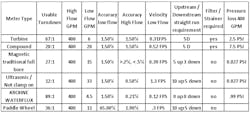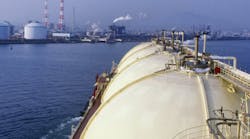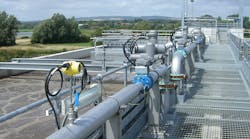Each year, water is a more valuable commodity and, each year, measuring water is a bigger business. As smaller water quantities are tracked — and given needs to identify water system leaks or theft — low flow measurement is increasingly looked to as a means for improved water-measurement accuracy.
It’s timely then to ask, what’s used to measure water today, and what can be expected from those instruments when measuring low flows? Further, how accurate and reliable are these measurement technologies under low flow conditions?
Devices used today for water-flow measurement include turbine, compound, paddle-wheel, ultrasonic and magnetic flowmeters. Also prevalent are positive-displacement (PD) and differential pressure (DP) meters. With the exception of PD and DP meters, the other flowmeters mentioned all directly measure flowing velocity. From the measured velocity, a volumetric measurement is calculated based on the meter’s cross-sectional area.
For our purpose, we will focus our attention on velocity-measurement devices.
Every user wants the most accurate reporting over the widest range of measurement. A meter’s turndown ratio expresses the "range of measurement that stays within the stated accuracy specification."
Turndown ratio can be determined by dividing the highest flow by the lowest flow possible. If the high flow to be measured is 1000 GPM and the low flow to be measured is 10 GPM, the desired turndown is said to be 100:1 or better. If the high flow is 100 and the low flow is 10 the desired turndown is 10:1 or better. Flowmeter users should select a meter that will cover the needed flow range with the necessary accuracy. This is referred to as "usable turndown."
Velocity matters – low flow, high flow
All flowmeters have a turndown ratio. It can be expressed as a ratio, e.g., 10:1; as a range of measurement, e.g., 1-100 GPM; or as a velocity span, e.g., 0.3 FPS to 20 FPS. What’s important is that the range be really "usable" for the flow measurement being made.
Just because a flowmeter can register 1200 GPM doesn’t mean it will ever see that high a flow. A flowmeter may have a turndown of 100:1. But in a nominal 4-inch pipe, the velocity at 1200 GPM would be 30.6 feet per second and at 1000 GPM 25.5 feet per second. These are not realistic water-distribution velocities. Pumping costs and frictions losses would be too high.
Here, velocity enters the discussion. For example, consider a flowmeter that can register flows between 1200 GPM and 12 GPM with a stated accuracy of .5% of the measured value — i.e., a typical stated range and accuracy for a 4-inch ultrasonic or magnetic flow meter. (In comparison, a typical 4-inch turbine meter may have an accuracy of 1.5% of measured value with maximum occasional flow of 1200 GPM and a normal or continuous flow of 1000 GPM.)
Highest flow normally expected in a 4-inch pipe would be 300 GPM, up to as high as 450 GPM. The equivalent velocities are about 7.5 to 10 feet per second. This "usable turndown" is closer to a nominal 25:1 or 30:1 than to the 100:1 that manufacturers state the meters to be capable of.
At the desired low flow rate of 12 GPM, velocity equates to ? of a foot per second. This and even lower flow rates are being scrutinized today.
Accurate accuracy
The next important factor for consideration is the instrument’s accuracy statement. Accuracy statements such as 0.5% of measured value for a magnetic flow or ultrasonic flowmeter and 1.5% of measured value for a turbine meter are common. For these meter types the accuracy statement is of measured value, which means as the flow goes lower or higher within the specified flow range, the accuracy will not change. For example, a stated accuracy of 0.5% is +/- ½ gallon at 100 GPM or +/- 5 gallons at 1000 GPM.
Other mechanical meters, such as paddle-wheels, have stated accuracies based on the maximum published range of the meter, such as 1% of maximum range. A typical range for a paddle-wheel meter is a flow rate of 12 GPM to 783 GPM in a 4-inch pipe, equating to a velocity of 0.3 to 20 feet per second. Given these parameters, error at 12 GPM could be as high as 7.83 gallons — 1% of the maximum range — or 65% of the measured value. When accuracy is stated as a function of maximum measuring range, the error will vary, becoming much more significant in lower flow conditions.
Turndown isn’t an issue for a flowmeter, assuming it is correctly specified, if flow is steady, e.g., at 250 GPM. Accuracy based upon maximum range and accuracy based on measured value can be viewed as equivalent, if the instrument will always be operating near the upper range. Thus, sometimes an inexpensive paddle-wheel will do the job as well as a more expensive DP meter. The lesson here is match the meter to the application for optimal performance.
Heart of matter
A flowmeter, though not the most expensive water system component, is critical as the means for registering water usage. If the meter over-reports water consumption, possibilities exist for end users not receiving water allotted or billed for. Conversely, if the meter is under-reporting, a greater amount of water is distributed than is being allotted or billed for. Better to select the meter with the best accuracy over the widest "usable" turndown.
The matrix below shows several types of water meters. All are velocity-type meters, and all require a full pipe for correct measurement. All come in sizes up to 6-inch diameters. Some are mechanical meters bearing extra components such as filter baskets to trap contaminants. Mechanical meters also require extra maintenance. Visual blade inspections, recalibrations due to wear and cleaning buildup on blades and other parts are among additional expenses to be considered.
Typically, high-flow rates in a 4-inch pipe are 400 GPM or 10.5 feet per second. This flow rate is used in the matrix for the upper flow; all meters are capable of measuring this flow rate; the pressure drop is acceptable with all meters; and the velocities noted are "somewhat" typical.
The low-flow rates are based on an error not greater than 1.5%, typically considered acceptable for these types of meters. Cross-over errors were not taken into account for the compound meter. The paddle-wheel error is based upon a stated accuracy of 1% of the maximum range, i.e., 783 GPM, based upon 20 FPS maximum in a 4-inch ID pipe.
Stated boldly
Further, non-mechanical electronic meters, such as magnetic and ultrasonic-inline meters have excellent low measurement accuracy when compared to their mechanical counterparts. Electronic meters, having no moving parts, need less maintenance. Electronic meters have low pressure drop and do not require filters, strainers or anything else to clean the water prior to registering flow totals. Pressure drop is miniscule, i.e., normally the same as the pipe in which the meter is installed.
It is the author’s contention that electronic type meters deserve serious consideration when contemplating low flow, and high flow, water measurement.
Keep in mind that suppliers’ statement of magnetic flow meter accuracy varies greatly by manufacturer. The majority are from 0.2% up to 1% of the measured value, with an additional zero-stability error which affects the meter’s low flow accuracy. The smaller this additional error specification is, the better the low flow performance of the meter.
In the table above, KROHNE’s WATERFLUX stands out as the most accurate choice of the electronic type meters over the entire range of measurement. The WATERFLUX can be powered by a battery or line power, requires no maintenance, has very little pressure loss and has no upstream or downstream straight run requirements.
Rich Lowrie is water and wastewater industry manager for KROHNE Inc.
KROHNE is a worldwide technological leader in the development, manufacture and distribution of accurate, reliable and cost-effective measuring instruments for the process industries.



